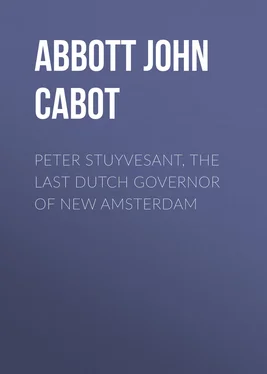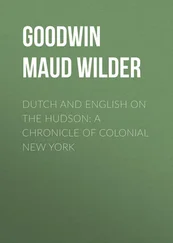John Abbott - Peter Stuyvesant, the Last Dutch Governor of New Amsterdam
Здесь есть возможность читать онлайн «John Abbott - Peter Stuyvesant, the Last Dutch Governor of New Amsterdam» — ознакомительный отрывок электронной книги совершенно бесплатно, а после прочтения отрывка купить полную версию. В некоторых случаях можно слушать аудио, скачать через торрент в формате fb2 и присутствует краткое содержание. Жанр: foreign_prose, История, foreign_edu, foreign_antique, на английском языке. Описание произведения, (предисловие) а так же отзывы посетителей доступны на портале библиотеки ЛибКат.
- Название:Peter Stuyvesant, the Last Dutch Governor of New Amsterdam
- Автор:
- Жанр:
- Год:неизвестен
- ISBN:нет данных
- Рейтинг книги:3 / 5. Голосов: 1
-
Избранное:Добавить в избранное
- Отзывы:
-
Ваша оценка:
- 60
- 1
- 2
- 3
- 4
- 5
Peter Stuyvesant, the Last Dutch Governor of New Amsterdam: краткое содержание, описание и аннотация
Предлагаем к чтению аннотацию, описание, краткое содержание или предисловие (зависит от того, что написал сам автор книги «Peter Stuyvesant, the Last Dutch Governor of New Amsterdam»). Если вы не нашли необходимую информацию о книге — напишите в комментариях, мы постараемся отыскать её.
Peter Stuyvesant, the Last Dutch Governor of New Amsterdam — читать онлайн ознакомительный отрывок
Ниже представлен текст книги, разбитый по страницам. Система сохранения места последней прочитанной страницы, позволяет с удобством читать онлайн бесплатно книгу «Peter Stuyvesant, the Last Dutch Governor of New Amsterdam», без необходимости каждый раз заново искать на чём Вы остановились. Поставьте закладку, и сможете в любой момент перейти на страницу, на которой закончили чтение.
Интервал:
Закладка:
"That the Dutch were anxious to secure the settlement of the Pilgrims under them, is freely admitted by the latter. Governor Bradford, in his History of the Plymouth Colony, acknowledges it, and adds that the Dutch for that end made them large offers.
"Winslow corroborates this in his 'Brief Narrative,' and adds that the Dutch would have freely transported us to the Hudson river, and furnished every family with cattle. The whole of this evidence satisfactorily establishes the good will of the Dutch people towards the English; while the determination of the States-General proves that there was no encouragement held out by the Dutch government to induce them to settle in their American possessions. On the contrary, having formally rejected their petition, they thereby secured themselves against all suspicion of dealing unfairly by those who afterwards landed at Cape Cod. It is to be hoped, therefore, that even for the credit of the Pilgrims, the idle tale will not be repeated."
There were many indications that a conflict would ere long arise between the Dutch and the English. The English repudiated entirely the Dutch claim to any right of possession on the Atlantic coast. They maintained their right to the whole American coast, from the Spanish possessions in Florida, to the French posts in Canada. The English government founded its claim upon the ground of first discovery, occupation and possession. Various companies, in England, had, by charters and letters patent from their sovereigns, been entrusted with these vast territories. It was quite evident that these conflicting claims between England and Holland must eventually lead to collision.
The Dutch merchants continued to push their commercial enterprises in New Netherland with great energy. They were preparing to send quite a large fleet of merchant vessels to the extensive line of coast which they claimed, when the British merchants composing what was called the Plymouth Company, took the alarm, and presented a petition to James I., remonstrating against such proceedings. The British government promptly sent an ambassador to Holland to urge the States-General to prohibit the departure of the fleet, and to forbid the establishment of a Dutch colony in those regions. The diplomacy which ensued led to no decisive results.
In the year 1623, the Dutch sent a ship, under captain May, and established a small colony upon the eastern banks of the Delaware, about fifty miles from its mouth. The settlement, which consisted of about thirty families, was in the vicinity of the present town of Gloucester. A fortress was erected, called Fort Nassau. This was the first European settlement upon the Delaware, which stream was then called Prince Hendrick's, or South River. Another fortified post, called Fort Orange, was established upon the western banks of the Hudson River about thirty-six miles from the island of Manhattan.
Very slowly the tide of emigration began to flow towards the Hudson. A few families settled on Staten Island. Not pleased with their isolated location, they soon removed to the northern shore of Long Island, and reared their log cabins upon the banks of a beautiful bay, which they called Wahle-Bocht, or "the Bay of the Foreigners." The name has since been corrupted into Wallabout. The western extremity of Long Island was then called Breukelen, which has since been Anglicised into Brooklyn.
The government of these feeble communities was committed to a Governor, called Director, and a Council of five men. One of the first Governors was Peter Minuit, who was appointed in the year 1624. The English still claimed the territory which the Dutch were so quietly and efficiently settling. In the year 1626, the Dutch decided to make a permanent settlement upon Manhattan island, which was then estimated to contain about twenty-two thousand acres of land. The island was purchased of the natives for twenty-four dollars. It was all that, at that time, the savage wilderness was worth. In that year the export of furs amounted to nineteen thousand dollars.
The colony soon numbered about two hundred persons. The village consisted of thirty log houses, extending along the banks of the East River. These cabins were one story high, with thatched roof, wooden chimneys, and two rooms on the floor. Barrels, placed on an end, furnished the tables. The chairs were logs of wood. Undoubtedly in many of these humble homes more true happiness was found than is now experienced in some of the palatial mansions which grace the gorgeous avenues of the city. About this time three ships arrived, containing a large number of families with farming implements, and over a hundred head of cattle. To prevent the cattle from being lost in the woods, they were pastured on Governor's, then called Nutten's Island.
And now the tide of emigration began pretty rapidly to increase. The Dutch transported emigrants for twelve and a half cents a day, during the voyage, for both passage and food. They also gave them, upon reaching the colony, as much land as they were able to cultivate. With a wise toleration, which greatly honored them, the fullest religious freedom of speech and worship was allowed.
A strong block-house, surrounded with palisades of red cedar, was thrown up on the south point of Manhattan Island, and was called Fort Amsterdam. This became the headquarters of the government and the capital of the extended, though not very clearly defined, realm of New Netherland.
An unfortunate occurrence now took place which eventually involved the colony in serious trouble. An Indian, from the vicinity of Westchester, came with his nephew, a small boy, bringing some beaver skins to barter with the Dutch at the fort. The narrow trail through the forest, led in a southeast direction, along the shore of the East River, till it reached what was called Kip's Bay. Then, diverging to the west, it passed near the pond of fresh water, which was about half way between what are now Broadway and Chatham streets. This pond, for a century or more, was known as the Kolck or the Collect.
When the Indians reached this point, they were waylaid by three white men, robbed of their furs, and the elder one was murdered. The boy made his escape and returned to his wilderness home, vowing to revenge the murder of his uncle. It does not appear that the Dutch authorities were informed of this murder. They certainly did not punish the murderers, nor make any attempt to expiate the crime, by presents to the Indians.
"The island of Manhattan," wrote De Rassieres at this time,
"is full of trees and in the middle rocky. On the north side there is good land in two places, where two farmers, each with four horses, would have enough to do without much grubbing or clearing at first. The grass is good in the forests and valleys; but when made into hay, it is not so nutritious for the cattle as the hay in Holland, in consequence of its wild state, yet it annually improves by culture.
"On the east side there rises a large level field, of about one hundred and sixty acres, through which runs a very fine fresh stream; so that land can be ploughed without much clearing. It appears to be good. The six farms, four of which lie along the river Hell-gate, stretching to the south side of the island, have at least one hundred and twenty acres to be sown with winter seed, which, at the most, may have been ploughed eight times."
There were eighteen families at Fort Orange, which was situated on Tawalsoutha creek, on the west side of the Hudson river, about thirty-six Dutch miles above the island of Manhattan. These colonists built themselves huts of bark, and lived on terms of cordial friendship with the Indians. Wassenaar writes, "The Indians were as quiet as lambs, and came and traded with all the freedom imaginable."
The Puritans had now been five years at Plymouth. So little were they acquainted with the geography of the country that they supposed New England to be an island. 1 1 Winslow in Young (p. 371).
Floating rumors had reached them of the Dutch colony at the mouth of the Hudson. Governor Bradford commissioned Mr. Winslow to visit the Dutch, who had sent a ship to Narragansett bay to trade, that he might dissuade them from encroaching in their trade upon territory which the Puritans considered as exclusively belonging to them. Mr. Winslow failed to meet the Dutch before their vessel had sailed on its return to Manhattan.
Интервал:
Закладка:
Похожие книги на «Peter Stuyvesant, the Last Dutch Governor of New Amsterdam»
Представляем Вашему вниманию похожие книги на «Peter Stuyvesant, the Last Dutch Governor of New Amsterdam» списком для выбора. Мы отобрали схожую по названию и смыслу литературу в надежде предоставить читателям больше вариантов отыскать новые, интересные, ещё непрочитанные произведения.
Обсуждение, отзывы о книге «Peter Stuyvesant, the Last Dutch Governor of New Amsterdam» и просто собственные мнения читателей. Оставьте ваши комментарии, напишите, что Вы думаете о произведении, его смысле или главных героях. Укажите что конкретно понравилось, а что нет, и почему Вы так считаете.












